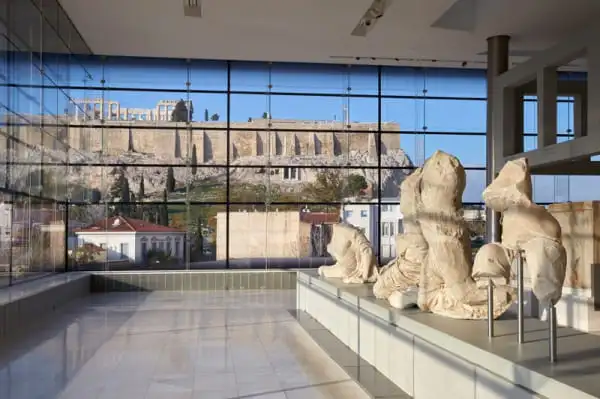
Athens, the cradle of Western civilization and a city steeped in history, offers a multitude of stunning viewpoints that provide a visual feast for those who seek a panoramic perspective of this ancient metropolis. From hilltops to historical sites, here are some of the best viewpoints in Athens, each offering a unique glimpse of the city’s splendor.
The Acropolis: Where History Meets Horizon
Greece, a country known for its rich history, has always been a place where the past seamlessly blends with the present. Among the many historical treasures scattered throughout this enchanting land, the Acropolis of Athens stands as a symbol of ancient grandeur, a place where history meets the horizon.
A Glimpse into the Past: The Acropolis, perched on a rocky hill overlooking the sprawling city of Athens, is an architectural marvel that transports visitors back in time. It’s the most iconic symbol of Greece’s classical period, dating back to the 5th century BC. The complex includes several ancient structures, but the Parthenon, dedicated to the goddess Athena, is the most renowned.
As you ascend the sacred rock, you can’t help but marvel at the precision and artistry that went into the construction of these temples. The ancient architects and craftsmen created a lasting testament to human ingenuity, leaving an indelible mark on world history.
A Meeting of Cultures: Over the centuries, the Acropolis has borne witness to a myriad of historical events and transformations. It has been a center of religious worship, a fortress, and even a palace. It has been through the hands of the Ancient Greeks, Romans, Byzantines, Franks, and Ottomans, each leaving their unique imprint on its grandeur. This layering of history has made the Acropolis an extraordinary fusion of cultures, where East and West, antiquity and modernity, come together.
A Contemporary Beacon: Today, the Acropolis is not just a relic of the past; it is a symbol of Greece’s enduring cultural legacy. As the sun sets over Athens, casting a warm glow over the ancient stones, the Acropolis still stands tall. This historical gem draws visitors from all over the world, making it a vibrant place where the past intersects with the present.
It has also been the canvas for many contemporary events, from political rallies to music concerts. This interaction between old and new makes the Acropolis an ever-evolving monument, where history continues to be written.
A Spectacular View: One of the most breathtaking aspects of the Acropolis is the view it offers. From its vantage point, you can gaze across Athens, taking in the sprawling metropolis as it extends towards the horizon. It’s a place where history literally meets the horizon, and the timeless beauty of the city merges with the surrounding landscape.
Preserving the Legacy: Preserving the Acropolis for future generations is a responsibility Greece takes seriously. Restoration efforts, ongoing since the 19th century, aim to safeguard this world heritage site. The Acropolis Museum, adjacent to the site, hosts many artifacts and sculptures, allowing visitors to connect with the past on a deeper level.

Lycabettus Hill: The City Beneath Your Feet
In the heart of Athens, where history and modernity coexist, one place offers a unique perspective on the Greek capital. Lycabettus Hill, a prominent landmark that rises above the bustling metropolis, provides an unparalleled view of the city beneath your feet.
A Natural Wonder in the Urban Jungle: Lycabettus Hill, also known as Lykavittos, is an ancient limestone hill that soars 300 meters (almost 1,000 feet) above sea level. Nestled amidst the urban sprawl of Athens, it stands as a tranquil sanctuary and a natural wonder in the midst of the bustling city. Its name, “Lycabettus,” is said to be derived from the ancient Greek word “lykos,” meaning wolf, and according to mythology, the hill was once a refuge for wolves.
The Climb to the Top: Ascending Lycabettus Hill is an adventure in itself. While you can take a funicular railway to the top, many choose to embark on the scenic hike. The winding path, flanked by pine trees and dotted with chapels, allows you to immerse yourself in the natural beauty of the hill and observe the changes in the landscape as you gain altitude.
A Panoramic View: The real reward for your effort is the breathtaking panoramic view that awaits you at the summit. As you reach the top, you’re greeted by a 360-degree view of Athens, stretching out to the Saronic Gulf. From here, the city appears as a living tapestry of history and modernity. You can see the ancient Acropolis, the neoclassical buildings of the city center, and the sprawling suburbs beyond. The blend of history, culture, and contemporary life is laid out before you like a grand spectacle.
Dusk and Dawn: Magical Moments: While Lycabettus Hill offers a mesmerizing view during the day, it truly comes alive at dusk and dawn. As the sun sets or rises, the city undergoes a transformation, and the Acropolis is bathed in the warm hues of the sun’s embrace. The city lights begin to twinkle, and you can witness Athens in its full splendor, capturing the essence of the “golden hour.”
A Place of Worship: Atop Lycabettus Hill, you’ll find the charming St. George’s Chapel, a whitewashed Greek Orthodox church with a rich history. It’s a serene place for reflection and a striking contrast to the vibrant city below.
An Escape from the Bustle: Lycabettus Hill is not just a viewpoint; it’s also an escape from the hustle and bustle of Athens. Locals and tourists alike come here to unwind, have a picnic, or enjoy a meal at the hilltop restaurants. Whether you’re seeking solitude, a romantic backdrop, or a place to connect with nature, Lycabettus Hill offers it all.
A City Beneath Your Feet: Lycabettus Hill invites you to stand above the city and experience Athens in a way that few other places can provide. It’s a unique vantage point that allows you to appreciate the contrasts and connections between the city’s past and present. As you gaze down upon Athens from Lycabettus Hill, you’ll come to understand that sometimes, the best way to truly grasp a city is to look at it from above, with the city beneath your feet.

Mount Philopappos: Tranquility in the City
Amidst the bustling urban life of Athens, where ancient history and contemporary culture collide, Mount Philopappos stands as a serene refuge. This ancient hill, named after a prominent figure from antiquity, offers a tranquil escape within the heart of the vibrant city.
A Name Rooted in History: Mount Philopappos, also known as Filopappou Hill, takes its name from Gaius Julius Antiochus Epiphanes Philopappos, a prominent Athenian benefactor who hailed from the royal dynasty of Commagene. Philopappos left his mark on the city by commissioning a grand monument atop the hill. Today, his legacy lives on in this serene natural space.
Natural Beauty in the Heart of Athens: This hill, with an elevation of 147 meters (482 feet) above sea level, offers an escape into nature without having to leave the city. It’s covered in pine trees, scrub, and wildflowers, making it a tranquil haven that provides a stark contrast to the bustling streets of Athens.
A Walk Through History: As you ascend Mount Philopappos, you’ll find a well-maintained walking path that leads to the summit. Along the way, you’ll encounter ancient ruins and historical sites that enrich the experience. The Prison of Socrates, a small cave believed to be the site where the philosopher Socrates was held before his execution, is one such intriguing relic.
A View to Remember: The reward for your ascent is a spectacular panoramic view of Athens, with the Acropolis taking center stage. At the summit, you’ll discover the Philopappos Monument, a grand mausoleum dedicated to Gaius Julius Antiochus Epiphanes Philopappos. From this vantage point, you can appreciate the city’s rich tapestry of history and modernity, as well as the Aegean Sea shimmering on the horizon.
The Silence of Tranquility: One of the most remarkable aspects of Mount Philopappos is the sense of tranquility it provides. As you explore the hill and sit in the shade of the pine trees, the city’s noise gradually fades into the background. It’s a place for reflection, relaxation, and a respite from the rapid pace of city life.
A Place for All Seasons: Mount Philopappos is a destination for all seasons. In the spring, the wildflowers carpet the hillside, creating a vibrant burst of color. Summer offers cool respite under the trees, and autumn transforms the landscape with golden hues. Even in winter, the hill maintains its charm, with a more peaceful ambiance and unobstructed views.
A Hidden Gem: While Athens is known for its historical landmarks and vibrant street life, Mount Philopappos remains a somewhat hidden gem. It’s a place where visitors and locals alike can find solace, connect with nature, and appreciate the fusion of history and nature within the heart of the city.
An Athens Retreat: Mount Philopappos stands as a testament to the enduring allure of Athens. It’s a place where tranquility thrives amidst the urban energy. Here, you can walk through history, find solace in nature, and gaze upon the city’s magnificent blend of ancient and modern. Mount Philopappos is a retreat within Athens, a place where you can experience the city from a different perspective, one that embodies serenity and harmony.

Areopagus Hill: A Rocky Overlook
In the heart of Athens, amidst the towering ancient ruins and vibrant city life, lies a place that whispers the secrets of history. Areopagus Hill, also known as Mars Hill, is a rocky outcrop that offers a unique perspective on Athens and the world of antiquity.
A Historical Landmark: Areopagus Hill has long been a site of historical and cultural significance. In ancient times, it was the location of the Council of the Areopagus, a high court in Athens. This council held sway over matters of both civil and criminal law, rendering it a central institution in Athenian democracy.
A Storied Past: One of the most famous events associated with Areopagus Hill is the sermon of the Apostle Paul, recounted in the New Testament. According to the Bible, the Apostle Paul addressed the Athenians from the hill, sharing his Christian beliefs. This event is often cited as an early instance of the intersection between Christianity and Greek philosophy, as Paul engaged with the local intellectual elite.
A Rocky Overlook: The charm of Areopagus Hill lies in its rugged simplicity. The ascent is relatively easy, though uneven, and is best undertaken during the cooler hours of the day. The reward for your effort is a magnificent view of the city and its historic landmarks.
Gazing Over Athens: As you stand on the rocky outcrop of Areopagus Hill, you’re treated to a panoramic view of Athens. The Acropolis, with its Parthenon and ancient temples, stands majestically before you. To the west, the modern city unfolds, offering a striking contrast to the ancient structures that dominate the landscape.
A Place for Contemplation: Areopagus Hill is not just a site for tourists and history enthusiasts; it’s also a place for quiet contemplation. The rocky terrain and the timeless atmosphere of this place make it ideal for meditation, self-reflection, or simply escaping the bustling city life for a while.
The Intersection of Past and Present: What makes Areopagus Hill truly special is its role as a bridge between the past and the present. It’s a place where you can stand amidst the very rocks where the great minds of ancient Athens once deliberated over matters of justice and law. It’s a place where the echoes of Apostle Paul’s teachings linger in the breeze, a testament to the enduring connection between faith, philosophy, and the human experience.
A Glimpse into History: Areopagus Hill is more than a rocky overlook; it’s a window into the rich history and intellectual legacy of Athens. It’s a place where the footsteps of ancient philosophers and early Christian missionaries still resonate. It offers a unique perspective on Athens, both in its current vitality and as a guardian of its timeless past. To visit Areopagus Hill is to touch the very essence of the city’s history and culture, and to connect with the ancient spirits that once roamed these rocky grounds.

Parnitha Mountain: A Natural Oasis
Amidst the bustling urban landscape of Athens, a natural gem awaits those seeking respite from city life. Parnitha Mountain, with its lush forests, pristine streams, and captivating wildlife, stands as a true natural oasis on the doorstep of the Greek capital.
A Natural Paradise: Parnitha Mountain, also known as Mount Parnitha, is situated to the north of Athens and is part of the Parnitha National Park. Its rugged terrain covers approximately 300 square kilometers (115 square miles), providing ample opportunities for adventure, exploration, and relaxation.
Flora and Fauna: The mountain is home to an impressive variety of flora and fauna. Parnitha boasts an extensive forest cover, including pine, fir, and oak trees, which provide shelter to diverse wildlife. Lucky visitors might spot deer, foxes, or even wild boars while hiking along its trails.
The Greek Ibex: One of the most iconic inhabitants of Parnitha Mountain is the Greek Ibex, also known as the “Kri-Kri.” This rare and elusive mountain goat is a symbol of the park and is protected within its boundaries. Lucky hikers may catch a glimpse of these remarkable animals navigating the steep cliffs and rocky outcrops.
Hiking and Outdoor Activities: Parnitha Mountain offers a variety of hiking trails that cater to all levels of experience. Whether you’re an avid hiker or just looking for a leisurely stroll, you’ll find a trail that suits your needs. The paths lead through dense forests, across glistening streams, and to breathtaking viewpoints that provide expansive vistas of the surrounding landscape.
The Flabouro Ski Center: During the winter months, Parnitha Mountain transforms into a snowy wonderland. The Flabouro Ski Center, located on the mountain’s slopes, offers opportunities for skiing and snowboarding. It’s a popular destination for winter sports enthusiasts, providing a unique contrast to the sunny beaches of the Greek islands.
A Place for All Seasons: Parnitha Mountain is not limited to a particular season. In spring, wildflowers carpet the hillsides, making it a botanical wonderland. Summer offers a cool escape from the city heat, with shaded trails and the chance to spot wildlife. In the fall, the vibrant foliage transforms the landscape into a sea of reds and golds. Winter brings a blanket of snow, creating opportunities for winter sports and a serene, snow-covered wonderland.
A Historical Legacy: Parnitha Mountain is not just a natural oasis; it’s also steeped in history. The ancient Athenians revered the mountain and associated it with the god Pan, the guardian of shepherds and flocks. Its rich history is evident in the numerous archaeological sites scattered throughout the region.
A Retreat from the City: In conclusion, Parnitha Mountain is a sanctuary of nature, an escape from the city’s urban chaos, and a tribute to the Greek countryside. Whether you’re a hiker, a nature lover, or just seeking a tranquil spot for a picnic, Parnitha Mountain offers a diverse range of experiences. It’s a place where you can reconnect with nature, explore rich history, and appreciate the incredible biodiversity that Greece has to offer, all within reach of the vibrant city of Athens. Parnitha Mountain truly is a natural oasis waiting to be explored.

Conclusion
Athens is a city of captivating viewpoints, each offering a unique perspective on this ancient and vibrant metropolis. Whether you’re drawn to historical landmarks like the Acropolis and Areopagus Hill or prefer the tranquility of natural vistas like Lycabettus, Mount Philopappos, or Parnitha Mountain, the city will not disappoint. These viewpoints allow you to appreciate the beauty, history, and vitality of Athens from a lofty vantage point, making your visit to the city even more memorable and enriching.
More information
The Acropolis ticket grants visitors access to the archaeological site of the Acropolis and its slopes, including the Parthenon, the Theater…
The Acropolis of Athens is a testament to the rich history and culture of Greece and Western civilization. Over the centuries…
The Acropolis Museum is a modern museum located in Athens, Greece, which serves as a beacon for the preservation and…



